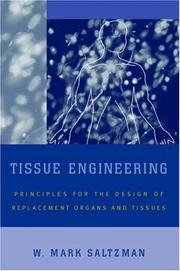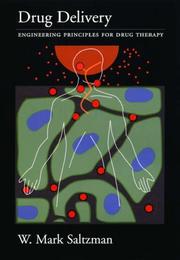| Listing 1 - 5 of 5 |
Sort by
|

ISBN: 0197561772 1280481625 0198032404 1433701049 9780198032403 1423719883 9781423719885 9781433701047 9786610481620 6610481628 019514130X 9780195141306 0190286458 Year: 2004 Publisher: New York, New York : Oxford University Press,
Abstract | Keywords | Export | Availability | Bookmark
 Loading...
Loading...Choose an application
- Reference Manager
- EndNote
- RefWorks (Direct export to RefWorks)
Tissue engineering is a new field of biomedical engineering, in which synthetic materials are used together with biological components such as tissue fragments, cells, proteins to encourage tissue regeneration, regrowth, and repair. This book introduces the principles of tissue engineering in a unique way that is ideally suited for the modern engineering student. A review of developmental biology is presented early in the book, since biological development is the fundamental process of most relevance for tissue engineering. The study of development provides a pathway to basic bioengineering units on cell adhesion, migration, assembly, and transport, which are integrated in the final sections of the book into tissue engineering processes (such as cell delivery, growth factor administration, and polymeric scaffold materials).
Tissue engineering. --- Biomedical engineering --- Regenerative medicine --- Tissue culture

ISBN: 0197560504 1628701587 1280442174 9786610442171 1423757661 019802469X 1601299524 9781423757665 9781628701586 0195085892 9780195085891 9781601299529 0199879753 9780198024699 9780197560501 Year: 2001 Publisher: Oxford : Oxford University Press, Incorporated,
Abstract | Keywords | Export | Availability | Bookmark
 Loading...
Loading...Choose an application
- Reference Manager
- EndNote
- RefWorks (Direct export to RefWorks)
This text is a synthesis of the principles that govern rates of drug transport, reaction, and disappearance in physiological and pathological situations, providing a working foundation for those in the field of drug delivery. The book covers advanced drug delivery and contemporary biomaterials.
Drug delivery systems. --- Biomedical materials. --- Biocompatible materials --- Biomaterials --- Medical materials --- Medicine --- Biomedical engineering --- Materials --- Biocompatibility --- Prosthesis --- Delivery systems, Drug --- Drug administration technology --- Drug delivery technology --- Drugs --- Pharmaceutical technology --- Delivery systems --- Bioartificial materials --- Hemocompatible materials --- Biomaterials (Biomedical materials) --- Polymers. --- Pharmacokinetics. --- Drug kinetics --- Kinetics, Drugs --- Chemical kinetics --- Pharmacology --- Polymere --- Polymeride --- Polymers and polymerization --- Macromolecules --- Kinetics --- Pharmacokinetics --- Metabolism
Book
ISBN: 9781107037199 1107037190 Year: 2017 Publisher: Cambridge: Cambridge university press,
Abstract | Keywords | Export | Availability | Bookmark
 Loading...
Loading...Choose an application
- Reference Manager
- EndNote
- RefWorks (Direct export to RefWorks)
"The second edition of this popular introductory undergraduate textbook uses examples, applications, and profiles of biomedical engineers to show students the relevance of the theory and how it can be used to solve real problems in human medicine. The essential molecular biology, cellular biology, and human physiology background is included for students to understand the context in which biomedical engineers work. Updates throughout highlight important advances made over recent years, including iPS cells, microRNA, nanomedicine, imaging technology, biosensors, and drug delivery systems, giving students a modern description of the various subfields of biomedical engineering. Over 200 quantitative and qualitative exercises, many new to this edition, help consolidate learning, whilst a solutions manual, password-protected for instructors, is available online. Finally, students can enjoy an expanded set of leader profiles in biomedical engineering within the book, showcasing the broad range of career paths open to students who make biomedical engineering their calling"-- Provided by publisher
Book
ISBN: 0521840996 9780521840996 Year: 2009 Publisher: Cambridge : Cambridge University Press,
Abstract | Keywords | Export | Availability | Bookmark
 Loading...
Loading...Choose an application
- Reference Manager
- EndNote
- RefWorks (Direct export to RefWorks)
Biomedical engineering. --- Biotechnologie --- Biotechnology --- Génie biomédical --- Génie biomédical
Book
Year: 2007 Publisher: Cambridge : Cambridge University Press,
Abstract | Keywords | Export | Availability | Bookmark
 Loading...
Loading...Choose an application
- Reference Manager
- EndNote
- RefWorks (Direct export to RefWorks)
| Listing 1 - 5 of 5 |
Sort by
|

 Search
Search Feedback
Feedback About UniCat
About UniCat  Help
Help News
News